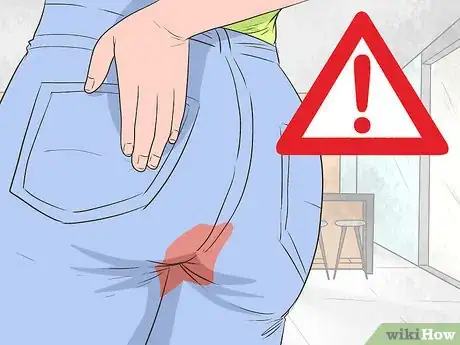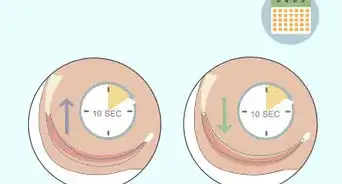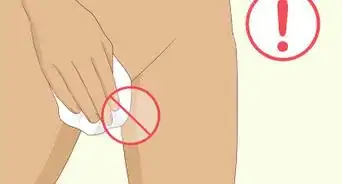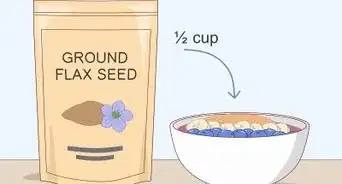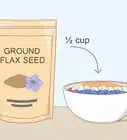This article was co-authored by wikiHow staff writer, Danielle Blinka, MA, MPA. Danielle Blinka is a Writer, Editor, Podcaster, Improv Performer, and Artist currently living in Houston, TX. She also has experience teaching English and writing to others. Danielle holds a Bachelor of Arts in English, Bachelor of Arts in Political Science, Master of Arts in English with a concentration in writing, and Master of Public Administration from Lamar University.
This article has been viewed 160,651 times.
Learn more...
Although some people may not bleed after an abortion, it’s completely normal to bleed from anywhere between 2 to 6 weeks after having one. You may notice that the bleeding resembles your period, as your body is shedding the lining of your uterus.[1] The best way to relieve your bleeding is to give yourself a deep uterine massage, rest, and avoid drinking alcohol. Additionally, you can relieve your discomfort. Although bleeding is normal, you need to see a doctor if it’s very heavy or shows signs of infection, like a bad smell.
Things You Should Know
- Reduce your bleeding by limiting activity levels, avoiding alcohol, and giving yourself a uterine massage for 10 minutes.
- A heating pad or over-the-counter NSAIDs (if your doctor approves them) can help ease your pain following an abortion.
- Call your doctor immediately if you're worried you have an infection, or if your bleeding is itchy, painful, foul-smelling, or excessive.
Steps
Caring for Yourself at Home
-
1Watch for bleeding about 3 to 5 days after your abortion. It’s common to have no bleeding or only light spotting for the first few days after an abortion, so don’t worry if you suddenly start bleeding days afterward. The bleeding may be light for some people, but it’s usually similar to a very heavy period. You’ll likely notice thick clots, as well as dark blood that’s almost black or brown.[2]
- Unless the bleeding is very heavy or lasts longer than 6 weeks, it’s usually not a concern. However, check with your medical provider if you feel worried.[3]
Tip: Since it’s normal to have spotting, you may notice that the bleeding stops and then starts again.
-
2Give yourself a deep uterine massage to relieve heavy bleeding. Position your fingers just below your belly button, then press down on your abdomen to apply firm, even pressure. Work your fingers from your belly button down to your pelvic bone, making a circular motion as you rub. Continue moving your fingers around your abdomen for up to 10 minutes to help reduce heavy bleeding and discomfort.[4]
- You can do this as often as needed to get relief.
- The deep uterine massage helps you shed your uterine lining more easily, so it shortens the length of time you bleed. Plus, it breaks up the tissue and helps relieve your discomfort.
Advertisement -
3Reduce your activity level, as too much activity can cause bleeding. Moderate to strenuous activity can trigger your bleeding, making it worse. Fortunately, resting can help slow down your bleeding, especially if it’s caused by increased activity. Your body needs rest after an abortion, so don’t push yourself too hard.[5]
- Take a break from exercise for at least a week after your abortion, even if you feel like you have the energy to do it. Otherwise, you may experience more bleeding.
-
4Avoid drinking alcohol, which can increase bleeding. If you enjoy drinking, you’ll be able to have a drink within a few days. Most people only need to abstain from alcohol for about 2 days after bleeding starts.[6]
- If you use marijuana or street drugs, it’s also best to avoid these, as well, since they can increase bleeding.
Coping with Post Abortion Bleeding
-
1Take over-the-counter NSAIDs to help with pain, if your doctor approves it. It’s normal to feel cramping and discomfort after your abortion, and it may continue for a few weeks. NSAIDs like ibuprofen (Advil, Motrin) and naproxen (Aleve) can relieve your discomfort and reduce inflammation in your body. Additionally, they can help thin out your bleeding so it’s over more quickly.[7]
- NSAIDs aren’t a good option for everyone, so talk to your doctor before taking them. Additionally, it’s not safe to take NSAIDs for a long period of time, as they can cause issues like stomach bleeding.[8]
- If you can’t take NSAIDs, ask your doctor if you can take acetaminophen (Tylenol) instead. It can help with pain, though it doesn’t reduce inflammation.
-
2Apply a warm compress or heating pad to your lower abdomen for pain. Fill a hot water bottle and hold it against your skin. If it feels too hot, put a towel around it. As another option, use a single-use disposable heat wrap or a heating pad to find relief.[9]
- The warmth will reduce your pain naturally.
- You can find single-use disposable heat wraps made for use during your period, which are a good option for relieving post-abortion discomfort.
Tip: Never sleep with a heating pad on your body, as it may burn your skin.
-
3Take some time for rest so your body can heal itself. An abortion is a medical procedure, so your body needs time to heal. Allow yourself to take it easy for at least a few days after your abortion. This will help you avoid complications, as well as excessive bleeding.[10]
- If you can, take a few days off work. Otherwise, talk to your boss about reducing your workload. Say, “I’m under my doctor’s care right now and need to take it easy for a few days. Can we alter my schedule for the next 2 days?”
-
4Talk to someone you trust if you’re feeling stressed or upset. It’s normal to have a wide range of emotions after you have an abortion because your hormones are fluctuating. Additionally, it can be a stressful, uncomfortable experience. It’s best to rely on your support system during your recovery so you can talk about your feelings.[11]
Tip: If you don’t feel comfortable opening up to someone you know, ask your clinic if they provide counseling services. Many offices offer this service free of charge.[12]
Getting Medical Care
-
1See a doctor immediately if the bleeding is itchy, painful, smelly, or pus-like. These can be signs of infection. Although most people don’t experience complications after an abortion, infection is the most common one. If you suspect you may have an infection, call your doctor for a same-day appointment or visit an urgent care center.[13]
- Your doctor may prescribe an antibiotic for you if they believe you are susceptible to an infection or see signs of a possible infection, such as a mild fever. If you receive antibiotics, take the entire prescription, even if you feel okay.
Tip: Your clinic may offer a 24 hrs helpline that you can use if you have any concerns after your abortion, including heavy bleeding. For instance, each Planned Parenthood gives you a local helpline number in the paperwork you take home with you.
-
2Call your doctor if you soak 2 maxi pads in 2 hours or have a fever or large clot. People who experience heavy bleeding may soak through a maxi pad in 1 hour. While heavy bleeding for a short period of time may be no cause for concern, it’s best to see your healthcare provider if it happens for 2 hours or more. Similarly, a fever or a blood clot that’s the size of a lemon or larger may indicate something is wrong.[14]
- Call the clinic where you had your abortion to ask if you need to come in for a follow-up visit. In some cases, they may prescribe medication that can help with your bleeding.
-
3Ask your doctor if a prescription medicine to stop bleeding is right for you. Bleeding is a normal part of abortion recovery, as your body returns to its pre-pregnancy normal. Because it's normal, your doctor likely won’t give you anything to address the bleeding. However, here are a couple of medications that may speed up the process:
- Your doctor may prescribe Methergine or Ergotamine after your abortion to help your uterus shrink back to its normal size. This also helps you stop bleeding faster. Typically, you’ll take one tablet every 8 hours until your prescription is gone.[15]
- If you experience bleeding after a drug-induced abortion, a medication called Yaoliuan capsule can help relieve bleeding and may heal your uterus faster.[16]
Warnings
- In the 2 weeks after an abortion, you’re at a great risk of infection because your cervix hasn’t yet closed all the way. To reduce your risk, avoid using tampons, having sex, and swimming for that first 2 weeks.[18]⧼thumbs_response⧽
- You can ovulate within 2 weeks of having your abortion, so it’s possible to get pregnant again before you’ve even had your next period, which may take 4-6 weeks to return. If you’re sexually active, make sure you’re using your preferred birth control method if you don’t want to become pregnant again.[19]⧼thumbs_response⧽
References
- ↑ https://www.medicalnewstoday.com/articles/322533.php
- ↑ https://www.plannedparenthood.org/planned-parenthood-michigan/healthcare/abortion-services/caring-for-yourself-after-an-abortion
- ↑ https://www.medicalnewstoday.com/articles/322533.php
- ↑ https://www.plannedparenthood.org/planned-parenthood-michigan/healthcare/abortion-services/caring-for-yourself-after-an-abortion
- ↑ https://www.plannedparenthood.org/planned-parenthood-michigan/healthcare/abortion-services/caring-for-yourself-after-an-abortion
- ↑ https://everywomanshealthcentre.ca/aspiration-aftercare/
- ↑ https://www.medicalnewstoday.com/articles/322533.php
- ↑ https://www.fda.gov/ForConsumers/ConsumerUpdates/ucm107856.htm
- ↑ https://www.medicalnewstoday.com/articles/322533.php
- ↑ https://www.plannedparenthood.org/planned-parenthood-michigan/healthcare/abortion-services/caring-for-yourself-after-an-abortion
- ↑ https://www.mayoclinic.org/tests-procedures/medical-abortion/about/pac-20394687
- ↑ https://everywomanshealthcentre.ca/aspiration-aftercare/
- ↑ https://www.plannedparenthood.org/planned-parenthood-michigan/healthcare/abortion-services/caring-for-yourself-after-an-abortion
- ↑ https://www.mayoclinic.org/tests-procedures/medical-abortion/about/pac-20394687
- ↑ https://www.plannedparenthood.org/planned-parenthood-michigan/healthcare/abortion-services/caring-for-yourself-after-an-abortion
- ↑ https://www.ncbi.nlm.nih.gov/pubmed/16201292
- ↑ https://www.plannedparenthood.org/planned-parenthood-michigan/healthcare/abortion-services/caring-for-yourself-after-an-abortion
- ↑ https://www.medicalnewstoday.com/articles/322533.php
- ↑ https://www.mayoclinic.org/tests-procedures/medical-abortion/about/pac-20394687
About This Article
To stop post-abortion bleeding, massage your lower abdomen with your fingers for 10 minutes, which will speed up the natural bleeding process and help with the pain. Also, take a break from exercise for at least a week after your abortion since too much activity can cause bleeding. You should also try to avoid alcohol for a couple of days since alcohol can make the bleeding worse. If you soak 2 maxi pads in 2 hours, have a fever, or have a large blood clot, contact the clinic where you had your abortion. For more advice on how to alleviate pain caused by post-abortion bleeding, keep reading.
